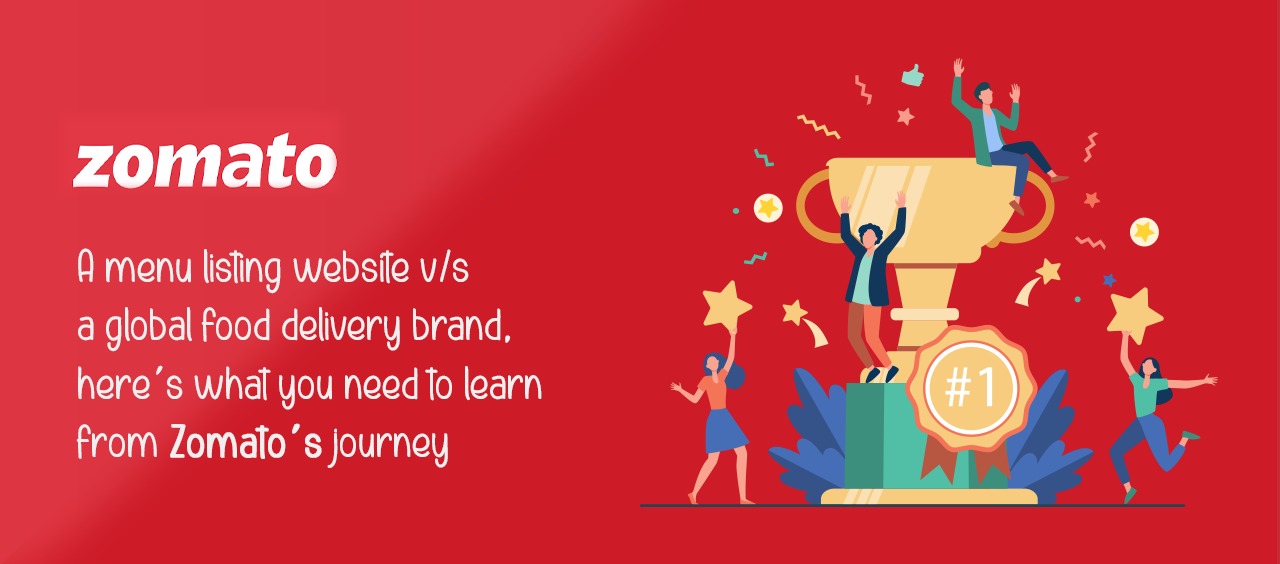
After having to scrounge around food menus for a really long time, the founders of Zomato decided to start off with an internet directory for restaurant menus. The company, which initially started off as a rebranded version of the food directory services, is now worth $2 billion. It holds the second position in the Food and Drinks restaurant and delivery service category.
Their brand story is probably known to everyone but what people don’t know is that Zomato didn’t try to beat competition, INFACT CHANGED ITS COMPETITION as they grew. From what to what, let’s read more.
The Gap
One day, while Deepinder Goyal was in his office, he saw his colleagues struggling to order food from a close by restaurant as they couldn't find the menu online. Deepinder, who later became the founder, soon realised that just like his colleagues, other people would also be looking for a single channel for restaurant menus and dining options. So he started designing a website and began uploading menus there. Soon, word spread and eventually led to the creation of Zomato, the one-stop shop for all dining needs.
The concept
Zomato started primarily as a website where people could compare menus and prices. In-fact, Zomato was not initially about food delivery. As the site became popular and its reach grew, the Zomato lovers began suggesting the need for more options and that's how the brand started integrating different services into its website, developed an app, and today Zomato is all about food -delivery.
Zomato has been working on its 4 metric approach AAAQ, A - Assortment, A - Affordability, A - Accessibility, Q - Quality. Brand executives believe that if all four of the above metrics improve, consumers are more likely to order food than cook it, and the unspoken growth of the restaurant industry will begin.
The challenges
In Delhi, the birthplace of the brand, the general culture is to remember restaurants with their signature offerings. For example, ITC Maurya is known for its Dal Bukhara and family naan. So when someone thinks of Dal Bukhara, they are immediately referred to the hotel. And this trend was followed by many other big restaurants who lure their customers with a signature dish and then offer them other variants to keep them loyal.
However, the real challenge was posed by the small and mid-sized emerging restaurants that did not have the budget to invest in PR or advertising, nor did they have an existing loyal clientele. Zomato helped bridge this gap for the micro businesses.
By allowing restaurants to upload their menus for free, the brand enabled them to showcase their offerings to a large customer base, driving traffic to their restaurant. The problem of "getting discovered" was now solved and slowly, from small to large, every restaurant started registering on Zomato.
However, this brought the next challenge, which was whether these listed restaurants were actually any good. And that's when Zomato introduced the rating system, which allows diners to rate their experience at a restaurant, helping others make choices and avoid mistakes they have made themselves. Today, Zomato has its own team that monitors such reviews and ensures that there are no fake reviews.
Zomato, as a brand, pays a lot of attention to feedback and quality control. While they make sure to add new services, they also make sure that their operations team closely monitors every move from the ground up.
There are many restaurants that have launched their own food ordering apps, which can be seen as a demand shift. The advantage for Zomato of having a marketplace model will always keep Zomato in the race. Restaurants may have to sit back and evaluate the cost they spend on maintaining such apps or websites, while Zomato will do the same for them without any increased overhead.
The expansion
After establishing himself in India, Deepinder wanted to take the brand overseas and so began Zomato's expansion to the East and West. However, building a business in different countries amidst such dynamically changing markets was difficult. But at the same time, the brand ethos was never questioned. Till date, every office of Zomato feels the same. High energy is the only mantra. Today, Zomato is present in 24 countries with around 20 million active accounts.
The innovations
Despite its huge popularity, Zomato has never stopped innovating its offerings to better meet the needs of its customers and this is what has given the company an edge over all its competitors. With the increasing growth of Zomato and the pride of reaching a figure of around $ 2 billion, the company still feels that it is able to give the micro businesses an edge in the market.
Soon after its launch, Zomato introduced its meal delivery option that made eating at home very popular. In fact, Zomato was one of the first brands to dispel the myth that ordering food was much more expensive than eating at home.
Your email address will not be published. Required fields are marked *
















Comments